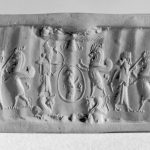The phrase in situ (lat. for ‘on site’) is used by archaeologists for artefacts which were found exactly at the place where they have been left behind after their last original use. Artefacts (incl. cuneiform tablets) which have been found in situ offer the advantage that they can be studied within their original context and therewith allow a more accurate and much easier reconstruction of past events and circumstances.
Archives: Tooltips
Hand copy
In connection with cuneiform texts we speak of hand copy or copy when the original tablet has been copied by hand (in ink on paper; nowadays usually digitally). Ideally such hand copies depict a tablet along with its individual characteristics such as its outer shape (incl. breaks) and the style of handwriting (incl. inaccuracies).
H. Rassam
Hormuzd Rassam (1826 Mosul – 1910 Hove) was a 19th century excavator in Iraq. He excavated among other places, in Nineveh, Borsippa, Babylon, and Sippar.
Foundation deposit
An object that has been buried under the foundation of a building during a ritual ceremony. For example, a cone or a cylinder seal with a cuneiform text commemorating the act of construction of the building.
Ezida
The temple of the Babylonian deity Nabû in Borsippa.
Archaeological excavation
Scientific archaeological excavations excavate and register with precision the soil layer in which archaeological remains are found, their position within these layers and their association with other finds on the site. The term ‘digs’ however is used to denote the illegal and non-scientific nature of an ‘excavation’.
Ebabbar
The temple of the Babylonian sun-god Šamaš in Sippar.
Docket
In the context of Neo-Babylonian (and Neo-Assyrian) studies the term does refer to cuneiform documents which were used as labels. As such they bear short cuneiform (or Aramaic) inscriptions and were attached to other documents (of perishable writing material) or to the (bundled or packed) commodities or items they refer to in their inscriptions.
De Liagre Böhl Collection
A collection of clay tablets and other ancient Near Eastern artifacts assembled by Prof. F.M.Th. de Liagre Böhl (1882-1976) housed in the Netherlands Institute for the Ancient Near East. See also here.
Cylinder seal
A small round cylinder, usually made of a kind of mineral or other stone, engraved with images and occasionally also text (in cuneiform script). The cylinder seal was rolled over wet clay to create a seal impression. Since one could keep on rolling continuously, one could cover a larger surface than with a stamp seal, which was also used in Neo- and Late-Babylonian times. A person could roll (or stamp) his seal on a document to prove ownership or his identity. A sealing thus functioned a bit like a signature nowadays.
Image: An impression of an Iranian cylinder seal (ca. 550-330 BCE) depicting the king fighting a lion-griffin.
Source: Walters Art Museum (CC0).
(CC0).